Term 3 Unit 3 | Geography | 7th Social Science - Natural Hazards - Understanding of Disaster Management in Practice | 7th Social Science : Geography : Term 3 Unit 3 : Natural Hazards - Understanding of Disaster Management in Practice
Chapter: 7th Social Science : Geography : Term 3 Unit 3 : Natural Hazards - Understanding of Disaster Management in Practice
Natural Hazards - Understanding of Disaster Management in Practice
Unit
-3
Natural
Hazards - Understanding of Disaster Management in Practice

Learning Objectives
• To understand the meaning of
natural hazards and disaster
• To get familiarise with natural
and man made disasters.
• To know about the disaster
management and disaster management cycle
• To know several survival
techniques
Introduction
Everyday almost all the newspapers
and television news channels carry reports on Natural hazards and disasters
that occurred in several parts of the world. Neither all the hazards nor all
the disasters can be preventable but the destruction can be minimized.
For better understanding, we must
know, what is a Natural Hazard? What is a Disaster? What is Disaster Management
and so on? Let us learn about some important terminologies along with disaster
management techniques.
Hazard
Generally, a hazard is a dangerous
phenomenon, substance, human activity or condition that may cause loss of life,
injury, health impacts, property damage, loss of livelihoods, services, social
and economic disruption or environmental damage. Natural hazards are natural
phenomenon that might have negative impact on human or the environment. Natural
hazards are classified into two broad categories: Geophysical and biological.
Disaster
A disaster can be generally defined
as “A serious disruption in the society causing widespread material, economic,
social or environmental losses which exceed the ability of the affected society
to cope using its own resources”. Disaster impacts may include loss of life,
injury,disease and other negative effects on human physical, mental and social
well-being,together with damage to property, destructionof
assets, loss of services, social and economicdisruption and environmental
degradation.
Hazards
are termed as Disasters when theycause widespread destruction of property
anduman lives.
Example
Hurricane is a natural hazard. It develops at sea. When it reaches land and destroysbuildings and kills people, it can be described as a disaster.
Types of Disasters

A. Natural Disasters
Earthquake
A sudden movement (or) trembling of
the earth crust is called as earthquake. The movement of the tectonic plates,
mass wasting, landslides, surface fault, etc., causes earthquake.
Effects
Due to a strong earthquake, loss of
lives, buildings, roads, bridges and dams are damaged. Earthquake cause floods,
tsunamis, landslides, fires, break down of water supply and electrical lines.
It may change the course of a river too.
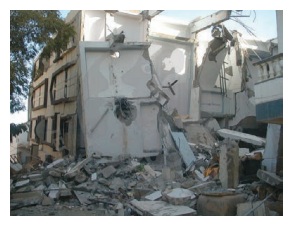
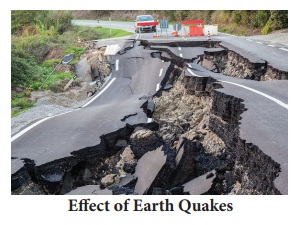
Recent
hazard in India and Tamilnadu
On 2nd to 3rd May 2018 a high
velocity dust storms swept across the parts of North India and more than 125
people died and over 200 were injured. In Uttar Pradesh 43 died in the city of
Agra and about 30 died other parts of the state. In neighbourhood of Rajasthan
state 35 people died and over 200 were injured. The wind downed more than 8000
electricity posts and uprooted hundreds of trees.
After 2004 tsunami, cyclone Gaja is
the worst natural disaster to hit Tamilnadu. It left a trail of destruction in
several coastal districts and took a toll on agriculture to a serious extent.
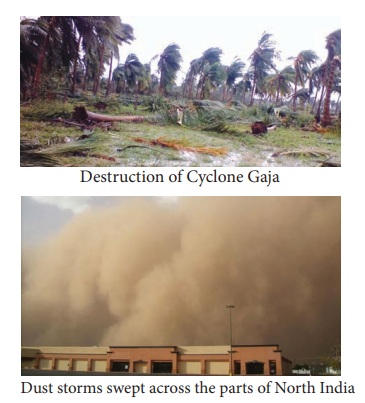
Tsunami
When
earthquake jolts the ocean floor, the sudden dislocation of the sea bed occurs
and the resulting displacement of water can produce one or more huge,
destructive waves, known collectively as a Tsunami. The sea waves rise to
several meters and may reach the coast within a few minutes.
Effects
It
causes flooding and disrupts transportation, power communication and water
supply.

The word “Tsunami” is derived from the Japanese word. “Tsu”
means harbour and “nami” means waves.
Flood
Sudden overflow of water in a large
amount caused due to heavy rainfall, cyclone, melting of snow, Tsunami or a dam
burst.
Effects
1. Loss of life and property
2. Displacement of people
3. Spread of contagious diseases such as Cholera and Malaria etc.,

Cyclone
A low-pressure area which is encircled by high pressure wind is
called a cyclone.
Effects of cyclone
The main effects of tropical cyclone include heavy rain, strong
wind, large storm surges near landfall and tornadoes.
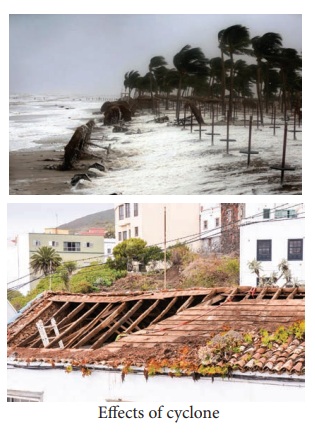
"Severe cyclonic storm Gaja
crossed the coasts of Tamilnadu and Puducherry around Vedaranyam and
Nagapattinam in the early hours of November 10, 2018 Friday with wind speed
gusting of around 120 (Kmph)" reported the Indian Meteorological
Department.
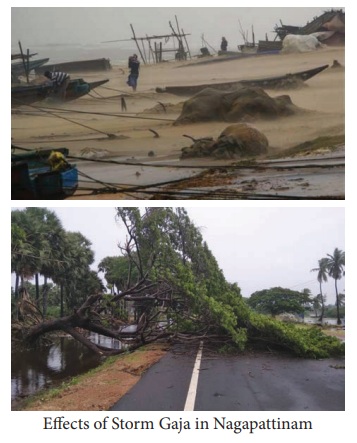
B. Man-made Disasters
Stampede
The term stampede is a sudden rush
of a crowd of people, usually resulting in injuries and death from suffocation
and trampling. It is believed that most major crowd disasters can be prevented
by simple crowd management strategies. Human stampedes can be prevented by
organization and traffic control, such as barriers, following queues and by
avoiding mass gathering.
Fire
Fire
is a disaster caused due to electrical short circuit, accidents in chemical
factory, match and crackers factory. Fire involves 3 basic aspects
1.
Prevention
2.
Detection
3.
Extinguishing
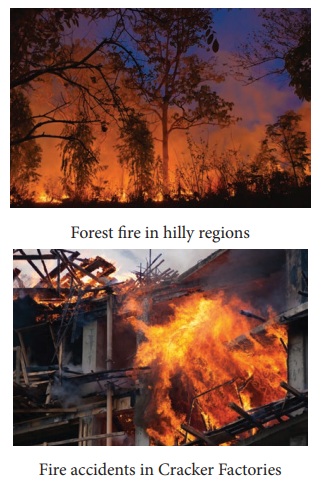
Public awareness of what to do
before fire, during fire and after fire is of critical importance.
Industrial Disaster
Industry faces multiple risks
involved with its production, transportation, storage, usage and disposal of
the effluents containing residuals and hazardous materials from nuclear and
chemical industries.
Example: Bhopal gas leakage
What is Disaster
Management?
The systematic process of applying
administrative directives, organizations, and operational skills and capacities
to implement strategies, policies and improved coping capacities in order to
lessen the adverse impacts of hazards and the possibility of disaster is called
Disaster Management.
Disaster Management is necessary or expedient for:
* Prevention
* Mitigation
* Preparedness
* Response
* Recovery
* Rehabilitation
Disaster Management Cycle or Disaster cycle
The six disaster management phases
that have been used in the concept of disaster cycle are as follows

Pre – Disaster Phase
Prevention and
Mitigation
Reducing the risk of disasters
involves activities, which either reduce or modify the scale and intensity of
the threat faced or by improving the conditions of elements at risk. The use of
the term reduction to describe protective or preventive actions that lessen the
scale of impact is therefore preferred. Mitigation embraces all measures taken
to reduce both the effects of the hazard itself and the vulnerable conditions
to it, in order to reduce the scale of a future disaster.
In addition to these physical
measures, mitigation should also be aimed at reducing the physical, economic
and social vulnerability to thr eats and the underlying causes for this
vulnerability. Therefore, mitigation may incorporate addressing issues such as
land ownership, tenancy rights, wealth distribution, implementation of
earthquake resistant building codes etc.
Preparedness
The process includes various
measures that enable governments, communities and individuals to respond
rapidly to disaster situations to cope with them effectively. Preparedness
includes for example, the formulation of viable emergency plans, the development
of warning systems, the maintenance of inventories, public awareness and
education and the training of personnel. It may also embrace search and rescue
measures as well as evacuation plans for areas that may be “at risk” from a
recurring disaster. All preparedness planning needs to be supported by
appropriate rules and regulations with clear allocation of responsibilities and
budgetary provision.
Early
Warning
This is the process of monitoring
the situation in communities or areas known to be vulnerable to slow onset
hazards, and passing the knowledge of the pending hazard to people harmless
way. To be effective, warnings must be related to mass education and training
of the population who know, what actions they must take, when warned.
The Disaster Impact
This refers to the “real-time event
of a hazard occurrence and affecting elements at risk. The duration of the
event will depend on the type of threat; ground shaking may only occur in a
matter of seconds during an earthquake. Where as flooding may take place over a
longer sustained period.
During Disaster Phase
Response
This refers to the first stage
response to any calamity, which include setting up control rooms, putting the
contingency plan in action, issue warning, action for evacuation, taking people
to safer areas, rendering medical aid to the needy etc., simultaneously
rendering relief to the homeless, food, drinking water, clothing etc. to the
needy, restoration of communication, disbursement of assistance in cash or
kind. The emergency relief activities undertaken during and immediately
following a disaster, which includes immediate relief, rescue, and the damage
needs assessment and debris clearance.
The Post- Disaster Phase
Recovery:
Recovery is used to describe the
activities that encompass the three overlapping phases of emergency relief,
rehabilitation and reconstruction.
Rehabilitation: Rehabilitation includes the provision of temporary
public utilities and housing as interim measures to assist long-term recovery.
Reconstruction: Reconstruction attempts to return communities with
improved pre-disaster functioning. It includes replacement of buildings;
infrastructure and lifeline facilities so that long-term development prospects
are enhanced rather than reproducing the same conditions, which made an area or
population vulnerable.
Development: In an evolving economy, the development process is an
ongoing activity. Long-term prevention/disaster reduction measures like
construction of embankments against flooding, irrigation facilities as drought
proofing measures, increasing plant cover to reduce the occurrences of
landslides, land use planning, construction of houses, capable of withstanding
the onslaught of heavy rain/wind speed and shocks of earthquakes are some of
the activities that can be taken up as part of the development plan.
Let us see in detail about a few
disaster management measures that are in practice in India.
Why mitigating the Hazards essential?
It is more cost-effective to
mitigate the risks from natural disasters than to repair damage after the
disaster. Hazard mitigation refers to any action or project that reduces the
effects of future disasters.
Warning System in
India
Department of Science and Technology
(DST) Department of Space (DOS) and CSIR Laboratories have set up early warning
system for tsunami and storm surges in the Indian Ocean.
Disaster Management in India
National Disaster Management Authority,
abbreviated as NDMA, is an agency of the Ministry of Home Affairs whose primary
purpose is to coordinate response to natural or man-made disasters and for
capacity-building in disaster resiliency and crisis response. NDMA was
established through the Disaster Management Act enacted by the Government of
India on 23rd December 2005.
The National Disaster Response Force (NDRF) is
a specialized force constituted for the purpose of specialist response to a
threatening disaster situation or disaster under the Disaster Management Act,
2005.
National Institute of Disaster
Management (NIDM) is a premier institute for training and capacity development
programs for managing natural disasters in India, on a national as well as
regional basis.
Disaster Management in Tamilnadu
*
Tamilnadu State Disaster Management Authority (TNSDMA)is responsible for all
measures for mitigation, preparedness, response, and recovery are undertaken
under the guidance and supervision of the Authority.
*
Tamilnadu State Disaster Response Force (SDRF) has been constituted with a
strength of 80 Police Personnel. They have been trained in disaster management
and rescue operations in consultation with National Disaster Response Force
(NDRF).
*
District Disaster Management Authority (DDMA) is responsible for Disaster
Management at district level
State Disaster
Management plan
The
perspective plan – 2018 -2030 prepared by the Revenue and Disaster Management
Department.
Hot
line between Indian Meteorological Department and the State Emergency Operation
Centre is established and mitigation in the District is done through telephone,
fax and IP phones also available which connect the State with District Head
Quarters, Taluks and Blocks of the State. Wireless radio network with both high
frequency and very high frequency are also available in the State.
General
Survival Techniques
*
During the earthquake be under the table, chair, kneel to the floor and protect
yourself. Go near a sturdy wall, sit on the floor and hold the floor strongly
and protect yourself.
*
Use only torch lights.
*
During flood forecast, store up necessary things like first aid. Listen to the
local Radio / TV for instructions. Cut off all the electrical supplies during
flood and earthquake.
*
In case of fire accidents dial 101 for fire service.
*
If clothes are on fire, “Don’t Run; Stop, Drop and Roll".
*
Road accidents can be avoided by permitting the persons only who have license
are allowed to drive. Learn, preach and practice safety rules during walking
and driving along the road.
*
Rail Safety Tips: Stay alert. Trains can come from either directions at any
time.
*
Never sit on the edge of the Station Platform.
*
Cross the tracks safely.
*
While on boarding the Air craft, pay attention to the flight crew safety
demonstration, and read the safety briefing card available in the seat pocket
carefully.
Wrap up
*
Both the hazard and the disaster cause enormous physical damage to property and
even make huge loss of life.
*
Disaster management refers to conservation of lives and property during a
natural or man-made disaster.
*
Preparation, Mitigation, Preparedness, Response, Recovery and Development are
the six Disaster management cycles
*
The state and the central government have various disaster management
organisations.
*
Earthquake, Tsunami, Flood Cyclone are some of the natural disaster.
*
Fire and Industrial accidents are few man-made disasters.
*
If any accidents occur dial 100 for Police, 101 for Fire service and 108 for
the Ambulance
*
If clothes are fire “Don’t Run, Stop, Drop and Roll”.
Glossary
1. Hazard a dangerous event
2.
Disaster an event which causes enormous damage to
property and fife
3.
Vulnerability severity
4.
Mitigate reduce (or) make something less severe
5.
Meteorology forecasting of weather
6.
Trembling shaking or vibration
7.
Preventive stop something before it happens
8.
Extinguish to stop a fire or light
9. Emergency
a serious, or dangerous situation
10.
Psychological Mental or emotional
state of a person
ICT
CORNER
Natural
Hazards
To
know about Natural disaster in detail through this activity.
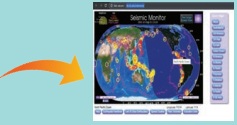
PROCEDURE
:
Step
1: Open the Browser and type the URL (or) Scan the QR Code.
Step
2: Seismic monitor page will appear on the screen.
Step
3: On the right side of the screen select the place or area.
Step
4 : Click the marked positions to view the detailed explanation about the
disaster

Natural Hazard URL: http://ds.iris.edu/seismon/
*Pictures are indicative only
*If browser requires, allow Flash Player
or Java Script to load the page.
Related Topics